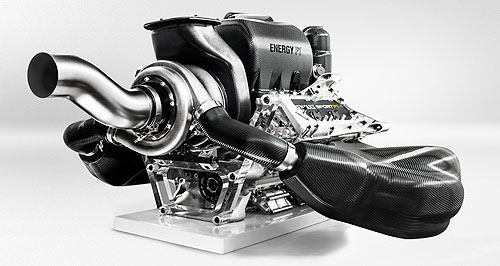Make / Model Search
News - RenaultRenault Sport F1 tech coming for the roadCharger: Renault has bolted an electric motor to the turbo-charger of its new F1 engine, to both charge the hybrid system energy store and reduce turbo-lag. Advances in Formula 1 technology to extend Renault hybrid and EV range on the roadGallery Click to see larger images 14 Mar 2014 RENAULT’S radical new Formula 1 turbo technology developed for the 2014 season will, over the coming years, improve the range and driveability of its road cars too. An all-new for 2014 Renault Sport F1 567kW/500Nm 1.6-litre V6 turbo engine captures energy from the waste exhaust gasses and turns it into electricity for a mandatory hybrid power system – as required by controversial regulations. In addition to its normal role of providing extra air for the internal combustion engine, a whopping turbocharger is connected to a dual-purpose electric motor called the MGC-H, which converts up to 40 per cent of the waste energy into power, while simultaneously boosting the petrol engine. Hybrid system skeptics had better listen up because the recovered power is not just required to make the cars faster. Each car has a fuel limit of 100kg per race, and without the range- and efficiency-increasing hybrid system, the cars wouldn’t be able to complete the full distance. However, a system which combines a turbo with an electric-motor/generator is not destined solely for the race-track. Renault Sport F1 head of track operations Remi Taffin predicts the technology will find its way on to public roads in the near future. “There are a lot of things to sort out. As soon as we have sorted out the problems in Formula 1 it should not be a problem to get it in to road cars,” he said while speaking with Australian media, including GoAuto, at Albert Park yesterday. “It’s just a matter of getting the price down. “We get something like 100kW from the engine just from the exhaust gas. That’s the part we would like to see on road cars.” Scavenging power from waste exhaust heat isn’t the only trick the MGC-H system can perform either. Feeding the stored electrical power back in the opposite direction turns the generator in to a high-speed motor capable of spinning the turbo up to speed – eliminating dreaded performance-sapping lag. “We can use that motor to speed up the turbo and try to get rid of the lag that’ s normally suffered by a turbocharged engine. If the engine is well used there should not be any lag and we should be able to match the normally aspirated engines,” Mr Taffin said. “We already see on some cars electric motors that spin the turbo, but obviously it’s taking energy out of the battery. Our system takes the energy out of the exhaust gas which is not needed by the car.” Mr Taffin claims the result is an engine with all the volumetric and thermal efficiency of forced induction but with the driveability of normal aspiration. As if that wasn’t clever enough the electric motor can be used to actually slow and limit the turbo’s speed – a job previously assigned to a component in the exhaust system called the waste-gate. Without a turbo speed limiter the compressor would be able to dangerously soar past its 100,000rpm peak, but the MGC-H brakes the turbo in the same way regenerative brakes slow a vehicle, preventing over-boost while producing useful electricity. Removing the waste-gate further simplifies the system and inherently improves reliability of both race and road engines alike. “The MGC-H is able at full power to deal with the boost pressure so there shouldn’t be the need for a waste-gate. “We are still running a waste-gate just as a back-up but it’s fair to say there is no need for normal purposes,” said Mr Taffin. Another larger electric motor called the MGC-K is connected to the engine crankshaft and performs a similar role to the turbine motor – sometimes powering the transmission system and other times using regenerative braking to charge the battery. Complex electronic management systems control when the pair of motors behave as actuators and when they should produce power and all largely without the driver’ s knowledge. While the various ingenious systems may one day find their way in to road cars, it was existing vehicle technology which provided the basis of the new Formula 1 engine. “We have 30 or 40 people at Renault Sport who developed our engine because direct injection and turbo-charging is all used in road car technology,” said Mr Taffin. “I think at Renault we have quite a lot to get from the company and the corporate because there are a lot of guys working on that technology, which we already have in the road cars.” The return to turbo-charged engines in Formula 1 has seen a dramatic cut of up to 40 percent in fuel consumption, but with only a minor loss of power over last year’s normally aspirated V8 engines and Mr Taffin believes it is just the start of advances in both race and road car technology. “There is one area that has not been explored and where Formula 1 is going to get the most out of for lap times - energy recovery systems. “If you look at the extra systems and the electric motors… that is where we are going to get the extra performance. That’s what we are focusing on.”  Read more |
Click to shareRenault articlesResearch Renault Motor industry news |




























Facebook Twitter Instagram